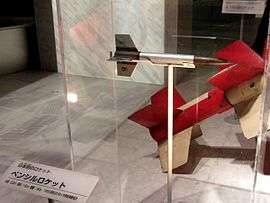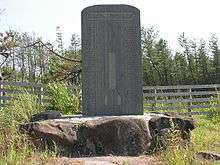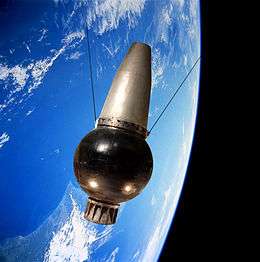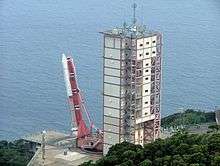Japan's space development

Japan's space exploration originated in the mid-1950s as a research group led by Hideo Itokawa at the University of Tokyo. Rocket sizes increased gradually from less than 30 cm (12 in) at the start of the project to over 15 m (49 ft) in the mid-1960s. The aim of the original research project was to launch a man-made satellite.
By the 1960s, two organizations, the Institute of Space and Astronautical Science (ISAS) and the National Space Development Agency of Japan (NASDA), were developing their own rockets. After experiencing numerous failures in the 1990s and 2000s, ISAS and NASDA merged — along with the National Aerospace Laboratory of Japan (NAL) — to form the unified Japan Aerospace Exploration Agency (JAXA) in 2003.
History
Dawn

Japanese space development was started by Tokyo University professor Hideo Itokawa. Many aeronautical engineers lost their jobs after World War II as aircraft development was banned under the US Occupation of Japan. This changed after the signing of the San Francisco Peace Treaty in 1951, which once again allowed the development of aviation technology. The seven-year stagnation of Japan's aerospace industry had seriously harmed Japanese technical abilities.[1][2] To address this, Itokawa established an aviation research group at the Institute of Industrial Science of the University of Tokyo. This institution succeeded in a horizontal launch of the Pencil Rocket on 12 April 1955 in Kokubunji, Tokyo. The dimensions of the rocket were 23 cm (9.1 in) in length by 1.8 cm (0.71 in) in diameter.[3] [4]
The rocket was the first experiment of its kind in Japan. This rocket was initially associated with the development of rocket aircraft and not with space exploration. However, with Japan's participation in the International Geophysical Year, the focus of the rocket project shifted towards space engineering.[5]
Early days

The Pencil Rocket eventually increased in size so that the experiment in the city outskirts was deemed too dangerous and the launch site was moved to Michikawa beach in Akita Prefecture.[6] Following the Pencil Rocket, the larger Baby Rocket was developed which finally reached an altitude of 6 km (3.7 mi). After the Baby Rocket, two rocket projects were further carried out: a rockoon type rocket launched from a balloon and a ground-launched rocket. The development of the rockoon turned out to be difficult and was eventually stalled.[1][7] Among the ground-launched rocket type, the Kappa rocket was one of the most successful, reaching altitudes that gradually increased over time. This rocket was also used for weather observation and participated in the data collection of the 1958 International Geophysical Year. Due to inadequate development funds at the time, the rockets were handmade and the tracking radar was operated manually. The production relied on trial and error, which brought forth many types of rockets.
In 1958, the Kappa 6 rocket reached an altitude of 40 km (25 mi) and the collected data allowed Japan to participate in the International Geophysical Year. In 1960, the Kappa 8 rocket exceeded an altitude of 200 km (120 mi). The development of larger rockets necessitated a launch site with a big downrange. The old site in Akita prefecture opening to the narrow Sea of Japan was deemed insufficient for this purpose and a new launch site opening to the Pacific was again created, this time at Uchinoura in Kagoshima Prefecture.
Launch of Ohsumi

In the 1960s, the information collected was primarily focused on satellites. A tentative plan was hatched whereby the Kappa Lambda rocket became the successor of this rocket, and the agency subsequently focused on gathering technical information from these launches in order to achieve higher maximum altitudes.
In 1963, the Science and Technology Agency established the National Aerospace Laboratory (NAL) where basic research on space technology was to be conducted. From about that time, the government started to gradually increase its effort with regard to space development. National Aerospace Laboratory is the insufficient development of space technology for facilities, the National Aerospace Laboratory separated only aviation technology, 1964 in STA is another as an institution, "Space Development Group," has been established.[1]
The University of Tokyo Aerospace division was established. Although the Lambda rocket development proceeded slowly, there were incremental improvements such as the new capability to reach 2000 km altitude, a figure that edged the scientists' efforts closer to the launch of a satellite. At this time, however, rocket technology became a political issue further stalling its development. There was, for instance, the controversy involving rocket guidance technologies, which some perceived to fall within military affairs. This was further aggravated by the continued failure of the Lambda rocket initiative, which lostt four Lambda in orbit.[1] The failure was reportedly caused by a shake that caused parts to slam against each other.
On February 11, 1970, the unguided banner L-4S rocket by orbiter from Japan the No. 5 Ohsumi was successfully launched. This was welcomed by the locals with a celebration.[8] The launch of Ohsumi was also important because it involved technological cooperation with the United States, particularly in the development of high efficiency batteries that did not lose power at high temperatures.[9]
Successful development
After the Space Development Group merged with ISAS and National Space Development Agency into one organization, space development started to achieve a modicum of success. Before this milestone, each of these agencies were developing their own rockets independently. For example, NASDA was focused on commercial applications rather than the improvement of a liquid fuel rocket technology.[10]

After the unification of the space agencies, Japan started to develop more precise rocket in the 1970s. Ohsumi launched a new rocket technology based on L-4S [Myuroketto]. Although the first M-4S rocket failed, the next iterations succeeded in orbit, with three satellites aircraft finally becoming the foundation of Myuroketto. The Myuroketto initiative simplified the system and impemented changes to the four-stage, three-stage rocket guidance and contro. All stages were capable of inducing the M3- S-type and this technology had a string of successful satellite launches into orbit, reaching higher altitude each time.
Engineering Test Satellite by these rockets Tansei and many other scientific satellites have been launched, ISAS began to store the information and satellite technology. Also, Yokkou come and firmament, such as atmospheric observation satellite, Hakucho and Hinotori such as X-ray astronomy satellite that was active. Development of the ISAS rocket M-3SII rocket dip in paragraph finished. The rocket is a solid fuel rocket is the first whole page, leaving the area to bring the gravity of the earth to the satellite Sakigake and Suisei to Halley Armada were participating. M-3SII to launch satellite rocket technology and an established one after another.
This is a larger solid rocket had to wait until the year 1997 MV appearance. Space Science for the next 10 years the government has a diameter of 1.4m rocket technical report expected to say more would not be enlarged, and the drawing up of this magnitude in both the National Space Development Agency, was subjected to further limit the National Assembly, it became difficult for larger.[11]
NASDA was initially planned to develop its own liquid rocket, rocket from the commercial need for immediate practical use, technology introduction luck in the universe from the United States signed an agreement with the United States U.S. Bitonatta. America [Delta rocket] using first-stage liquid engine was developed in Japan we began a program of LE-installed in the second stage liquid rocket 3. Thus N-1 rocket has been developed. However, the first liquid rocket was NI Rocket to the low orbit launch capability was inferior to the U.S. ability to produce satellites. Therefore, the [1977] geostationary meteorological satellites in the transfer of technology from the United States created by Sunflowers of the United States launched a rocket.[12] The Sakura and Yuri had launched rockets such as the United States. NI rocket technology was acquired only manufacturing technology and management techniques, often take the record, NASDA will gradually acquire technical skills, since the No. 2 satellite in the sunflower, it increased the localization went.
Since then, NASDA satellite to meet the requirements of NI larger rocket, the successor to N-II rocket started the development of the second stage [knockdown production] change, 300 kg close [Sunflowers No. 2] was able to put into a geostationary orbit. These rockets United States in Delta rocket in licensed production and the U.S. component knockdown production vehicle itself and the quality was very good, Apojimota and satellite black box not enter the information not yet made it even better when it fails has become. Thus, began the development of indigenous self-development that would require the entire rocket.[1] The newly developed HI rocket is a liquid fuel rocket research and development conducted on its own LE-5 engines to practical use, the second-stage rocket engine turned 2.[12] LE-5 is characterized by this feature can be re-ignition becomes more powerful N-II, HI capability of the rocket launch to geostationary orbit over 500 kg.
NASDA rockets are used for production of commercial satellite launch is much more rapid communication satellite and broadcasting satellites, meteorological satellites and the launch went. HI 9 aircraft are manufactured rockets, all of which successfully launched the satellite successfully launched multiple simultaneous first Japanese.[12]
Japan has not been developed for manned space flight, NASA in cooperation with Mouri Mamoru was scheduled to go first as a Japanese space by the shuttle accident in 1990, civilian There was Toyohiro Akiyama was first to go into space as a Japanese. He also became a first time as a civilian man went into space.
Integration and institutional failure

NASDA LE-5 engine will be successful, even in light of technological progress in Japan has decided to develop a purely domestic liquid fuel rocket technology to improve domestic technology. The development was initiated from 1984. H-II rocket is a redesign everything from scratch. Toward the domestic first-stage engine completely, with difficulties in its development. First stage was to develop a new type of Japan LE-7 rocket engines are used in high-pressure combustion of hydrogen and oxygen gas, or parts damage due to vibration, and durability of the material issues It took some time to resolve. Hydrogen is also caused by revealing the explosion. Solid rocket boosters had to take advantage of the solid rocket technology has continued research in space science laboratory. Takes years to develop 10, HI in the last two years after the launch [in 1994] decided to launch one rocket. [February 3,] was scheduled to be launched to put off a day fell from the launch pad for air conditioning duct fairing February 4, as the first complete domestic and liquid rocket became H-II rocket was launched in a rocket.[1]
On the other hand, the 1989 Space Science Institute [Space Development policy outline] enables the development of larger rockets conversions began in 1990 to develop rockets with solid rocket can planets. Problem occurs also in the development of rocket motors. The prolonged development, M-3SII again in 1997 after two years from the last flight of the rocket M-V was completed. Was born during a space launch vehicle for spacecraft Mars Nozomi was to postpone the launch of two years.
Japan was thus advanced the development of a rocket, [1990] (1990) and the USA trade policy, "Section 301" is applied, Japan international competitive bidding had to be practical for use in domestic satellites. This is useful for satellite launches, a lot to bring the US-made rocket that can launch more affordable, and produced a few high-cost domestic satellite, a commercial satellite in low-cost mass production of the West slightly enemy Himawari 5 was the successor to purchase American-made finished products.[1] Midori and environmental observation satellites for such,[13] HALCA astronomical satellites and experimental spacecraft and satellites is almost like a rocket can be launched in Japan, gave a great success of these satellites. However, it flowed overseas launch of commercial satellites is also the reason can not gain experience until now launch commercial rockets.
The late 1990s and early 2000s (decade) was to stumble on a newly developed rocket. H-II rocket flight 5 and flight 8 failed to launch in a row, M-V failed to launch even flight 4.[12] Nozomi failed to enter Mars orbit. Overlapping administrative reform movement from these failures and the occasion was to be proposed in the integration of government space agencies. Strengthening cooperation between organizations, prioritization of features, such as being a plan to streamline the organizational structure, Space Science Institute, October 1, 2003 (ISAS), National Space Development Agency (NASDA), aerospace Technology Laboratories (NAL) are integrated, Japan Aerospace Exploration Agency was established.[14] Integration was the first time since the launch of a space agency H-IIA flight 6, but failed to launch, the rocket launches have been successful since.
Currently
NASDA H-II we redesigned and simplified from a failed rocket launch H-IIA rocket was developed. Although this rocket failed shortly after launch integration, which will launch and many successful aircraft in 17 aircraft by September 18, 2010. Large payload to send equipment and supply to the international space station more H-IIB Rocket have been developed and is now in order to launch the satellite easier cheaper MV solid fuel new successor to the Rocket Rocket Epsilon rocket is also being developed.[15] These developments in Japan are pursuing the possibility of re-launching business.
Now a lot of satellites and experimental spacecraft to launch satellites in the country, became a strong technical capabilities in this field. No. 7 meteorological satellite Himawari can reduce costs by using satellite bus that was used to Kiku No. 8, was able to launch a domestic satellite weather again. Has been launched plans to launch a small scientific satellite lot, this plan is to allow for rapid development of inexpensive, custom-made satellites aims to share some semi.[16]
On the other hand, 1998 after missile tests by North Korea in the past, has never been done spy satellites is done and now the launch of the basic space law in 2008 finalized, now is made military use of space for defense purposes only. And is currently doing in this area and although the Japanese reconnaissance satellite and missile defense only. Budget has been diverted out of scientific space exploration budget for these plans, which put pressure on other technologies.[17] Space budget from other political factors tend to decrease. In addition, some factions of the organization state that the former JAXA affect the budget allocation. These are contributes to dampen the history of the Japanese space development.
The biggest success in recent years Hayabusa said feedback. Made the primary purpose of engineering experiments is the spacecraft in 2003 Uchinoura Space Center from MV asteroid was launched by rocket asteroid After exploring the 2010 returned to Earth.[18] There was a problem during landing when the landing on Itokawa, which had been most likely unable to collect samples of the asteroid, which contains a sample of asteroids in the capsules were returned, by which the spacecraft World The spacecraft was first brought back samples from an asteroid.[19]
In June 2014 Japan's science and technology ministry said it was considering a space mission to Mars. In a ministry paper it indicated unmanned exploration, manned missions to Mars and long-term settlement on the Moon were objectives, for which international cooperation and support was going to be sought.[20]
Organization
Japan's space development Institute of Industrial Science, which began as a study group, and are based on the Engineering of Tokyo was the second aircraft before the war and developing sources I follow it. This study group in 1964 [Tokyo Institute of Aerospace] as an independent. In 1963, the State National Aerospace Laboratory launched, along with aircraft technology that it was done by National Aerospace Laboratory. 1969 NASDA was launched, Aerospace R & D technology exports grew from problems specific to science. Then in 1981, the Aerospace was reorganized and became the National Institute of Space and Astronautical Science. The momentum of reforms and administrative arrangements-government organizations held in the early 2000s (decade) from the 1990s, overlapping the failure of the launch rocket, a consistent these institutions are necessary to strengthen cooperation organization, Japan Aerospace Exploration Agency (JAXA) was launched.[14][21] Currently, Japan's space development JAXA is responsible for one hand.
Facilities
Defunct Facilities
- Akita Rocket Test Site
- JAXAi
Companies
Rocket range

There are two facilities in Japan with the ability to launch satellites: the Tanegashima Space Center and Uchinoura Space Center. NASDA liquid fuel rockets are launched from Tanegashima, while ISAS solid fuel rockets are launched from Uchinoura.
In addition to the above two locations, there are other facilities able to launch test rockets.
Akita Rocket Test Site was used as a test launch facility since 1955 from the University of Tokyo. This test site was used for the last time in 1965 by the National Aerospace Laboratory, and now only a monument remains to commemorate the site.
The [rocket weather station] was established in April 1970 and was active until March 21, 2001. The MT-135P rocket was launched a total of 1,119 times. We are currently observing the atmosphere as air quality stations.
[Shima Shin test site] rocket launch test was conducted over the Science and Technology in 1963 and 1965. The agency and the facility had been rented in the form tested. Aviation is currently a Branch Office of Research and Shima Shin equipped laboratory, we have launched trial operations of guided missiles and other weapons.
Taiki Aerospace Research Field in a private vehicle CAMUI Rocket has been made since the launch in 2002.
Also, in Japan is one of the Antarctic bases, Showa Station. Between 1970 and 1985, rockets have been launched by 54 groups for purposes such as ozone measurements and auroral observation.
Goals
Japan is a "safe and prosperous society" that wants to use aerospace technology to achieve progress, according to JAXA's long-term vision.[22]
- Natural disasters, support system for environmental issues
- Planetary sciences, and technical research for the advancement of asteroid exploration
- Improved reliability for stable transportation, related research and manned space activity
- Key industries
And has been incorporated.
Oriented development
Japanese rocket has been developed completely separated from the military technology for peaceful goals. Therefore, the purpose is commercial or scientific purposes with a lot of rockets and satellites. The initial observation satellites, a lot has been increasing and communications satellites and spacecraft gradually. Lead to the re-entry to military technology were ahead of 1994.
References
- 1 2 3 4 5 6 7 Tomifumi Godai (1994-04-30). 国産ロケット「H-II」宇宙への挑戦 [Domestic rocket H-II space challenge] (in Japanese). Tokuma Shoten. ISBN 4-19-860100-3.
- ↑ Mercado, Stephen C (September 1995). "The YS-11 Project and Japan's Aerospace Potential". JPRI. Retrieved 2015-07-02.
- ↑ 国分寺市からロケット発射 [Shooting a rocket from Kokubunji] (in Japanese). Kokubunji, Tokyo. Archived from the original on January 20, 2011. Retrieved 2011-01-17.
- ↑ Ley, Willy (December 1967). "Astronautics International". For Your Information. Galaxy Science Fiction. pp. 110–120.
- ↑ ある新聞記事 [Newspaper articles] (in Japanese). Institute of Space and Astronautical Science. Retrieved 2011-01-30.
- ↑ 日本発のロケット発射実験 [Japanese rocket shooting experiment] (in Japanese). Yurihonjō, Akita. Retrieved 2011-01-17.
- ↑ 六ヶ所村のミニ地球 [Rokkasho mini earth] (in Japanese). Space Association. Archived from the original on January 11, 2013. Retrieved January 25, 2011.
- ↑ "lambda glory". ISAS. Retrieved 2011-01-17.
- ↑ "The National Science Museum, February 7 "Ohsumi" 40th Anniversary Symposium". Astro Arts. Retrieved 2011-01-17.
- ↑ "NI Rocket". Japan Aerospace Exploration Agency. Retrieved 2011-01-17.
- ↑ "Subcommittee No. 2 on Space Development Special Committee of Science and Technology Promotion Association 051 Diet". Retrieved 2011-01-25.
- 1 2 3 4 Noda Masahiro (2000-03-27). Century Rocket. NTT Publishing. ISBN 4-7571-6004-6.
- ↑ Ministry Shima Hara. "Satellite "Midori" marine observation". National Institute for Environmental Studies. Retrieved 2011-01-25.
- 1 2 "Integration of three space agencies". Research and Development Bureau Ministry of Education. 2003-06-14. Archived from the original on January 27, 2013. Retrieved 2011-01-25.
- ↑ "Ipushironroketto". Japan Aerospace Exploration Agency. Retrieved 2011-01-17.
- ↑ "SPRINT (small scientific satellite) Outline Planning Series" (PDF). Japan Aerospace Exploration Agency. 2010-07-21. Retrieved 2011-01-26.
- ↑ Shinya Matsuura Susumu (2006-05-31). "lower costs at a crossroads in MV". nikkeiBPnet. Retrieved 2011-01-26.
- ↑ ""Hayabusa" feedback". The Nikkei. Retrieved 2011-01-17.
- ↑ "Spacecraft Successfully Returns Asteroid Dust". Science. Archived from the original on November 20, 2010. Retrieved 2011-01-29.
- ↑ "Japanese hope to build on Mars". The Tokyo News.Net. Retrieved 2014-06-02.
- ↑ "Ministry of Education, emphasis on efficient integration prospect 15 year space development agency three, years 30". Physical Society Division High School in Nara, Rika. Sankei. June 14, 2003. Archived from the original on September 4, 2010. Retrieved January 25, 2011.
- ↑ "JAXA2025 / long-term vision". Japan Aerospace Exploration Agency. Retrieved 2011-01-17.
External links
- History of Japanese Space Research (Institute of Space and Astronautical Science)
- History of the Japanese Aerospace Industry: 50 years (The Society of Japanese Aerospace Companies) (in Japanese)